|
Nov
14
2022
|
|
Posted 3 years 40 days ago ago by Admin
|
|
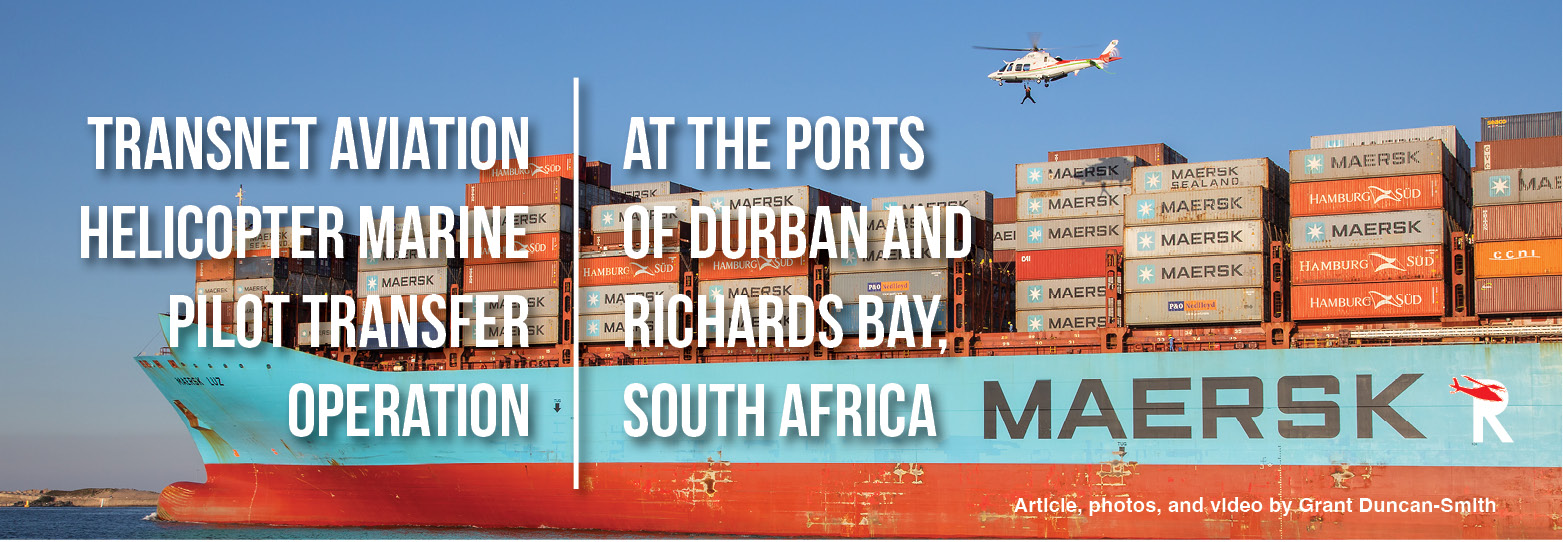
VIEW VIDEO
Large swells, high winds, tight vessel schedules that can change frequently during a single day and a narrow harbor entrance with various sand banks, makes Durban Harbour a challenging environment for any ship pilot to navigate. To assist the vessel pilots trying to enter or leave the harbor, Transnet Aviation transports skilled ship pilots with an intimate knowledge of the harbor to pilot the vessels.
South Africa was one of the first countries in the world to utilize a helicopter for marine pilot transfer, launching the Helicopter Marine Pilot Transfer (HMPT) concept in 1995.
HMPT operations are a high risk, hostile, and dynamic operating environment requiring exceptional flying skills and precision hoisting as well as efficient and flawless maintenance. It takes years of training to achieve the highest levels of proficiency in safety and efficiency. There are only a handful of qualified offshore helicopter pilots, experienced helicopter hoist operators and licensed aircraft maintenance engineers who have flown and worked on the marine pilot service, and who meet the stringent minimum requirements.
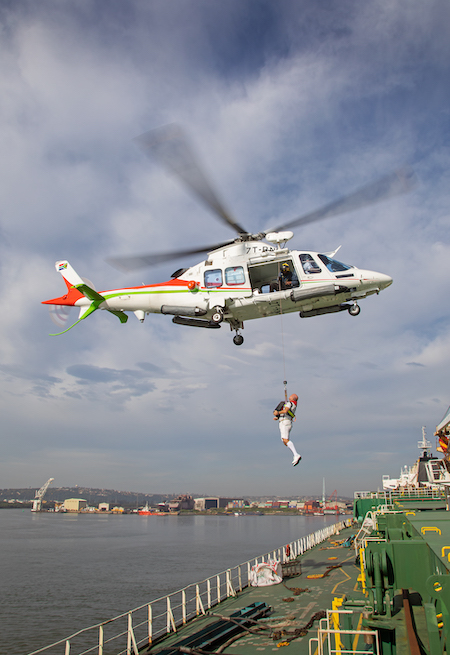
The helicopters used for offshore marine pilot transfer have equally stringent requirements. For this reason, Leonardo-manufactured helicopters have been in service since 1998 as a tried and tested platform, which is more than capable of handling the very demanding operational requirements of the Offshore Marine Pilot Transfer environment.
South Africa’s Transnet National Ports Authority’s HMPT operations is one of a few such operations globally and the only one on the continent of Africa. What makes South Africa’s HMPT operations even more unique is the fact that the predominant method of helicopter transfer is achieved through external load operations (winching).
More and more ports around the world are using helicopters to transfer the pilot to and from the vessel instead of the more traditional transport by pilot boat. This means that pilots can now transfer in increasingly challenging weather conditions.
HMPT operations require an advanced level of skill and experience in order to perform the task safely and efficiently. This very specific and restricted field of expertise is regarded as a specialist field within Transnet. Even recruiting the most experienced helicopter pilots from the industry, without marine pilot transfer experience, would take a minimum of a year of stringent training to gain proficiency as a Day Captain and another year to operate as a Night Captain.
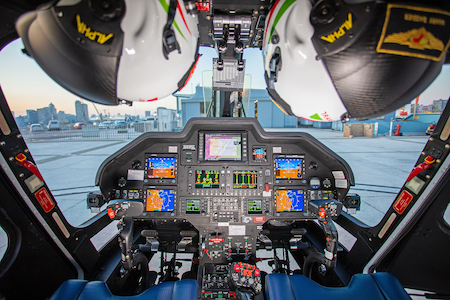
The helicopter flight crew at Transnet is ultimately responsible for operating an aircraft safely within meters of multi-million dollar’ vessels in all weather conditions, in a dynamic and sometimes unforgiving operating environment. Safely hoisting a marine pilot from a helicopter onto an unstable platform in rough seas, strong winds, torrents of rain, sometimes at night with near zero visibility, requires a serious level of skill, precision, and focus. It is in these conditions that the helicopter is one of the Port’s most useful tools as it’s the safest and only mode of transportation for marine pilots when a pilot boat is not able to service vessels in severe weather conditions. The Helicopter Captain must also be able to effectively and safely handle any unforeseen emergency that may occur during a flight in any conditions.
With great anticipation, I join Transnet’s crew for a day of flying at Durban Harbour. Their 12-hour shift starts in the dark at 05:00. The day’s preparations begin with washing the helicopter, refueling, engineers inspecting the helicopter from top to toe, and a briefing for the day’s flying. I can hardly contain my excitement as the weather is predicted to be warm and almost windless, and the flying schedule looks full.
My goal is to shoot photos and video from the breakwater of a container ship and from the helicopter operation. I also want to get images of the marine pilots hoisting onto vessels, the external load operator (ELO) and first-hand experience of myself being hoisted.
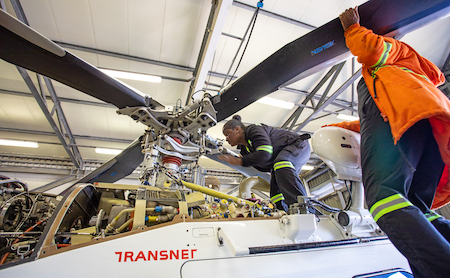
The first impression I have is of the well-planned processes of the operation from start to finish. The focus and depth of detail starts early in the morning with the engineering team inspecting the helicopter at the start of the day, to the helicopter being washed down at the end of the shift.
Briefing done, I complete an additional hoisting briefing,. Then refueling is finished and we are up. The first call of the day comes through, we grab our life jackets with personal locator beacon’s and head to the helicopter.
The aircraft’s configuration consists of the ELO positioned at the sliding door with an open gap adjacent to him and three seats opposite him. The helicopter pilots strap in and go through their checks; the engines start up and we are off. The first vessel is named Graceful Leader situated about 3 nautical miles offshore. We head through the harbor entrance and out to sea. Kim Watchurst, the co-pilot, completes radio calls to Virginia Air Traffic Control as we’ll pass through their airspace, and he contacts the vessel’s pilot to advise that we are close-by, the speed they should be at and the heading. Mark Bassier, the helicopter captain flies around the vessel to observe the winds and swells and to determine the best spot to lower the ship pilot.
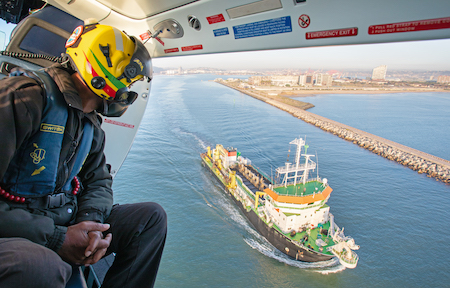
Flying adjacent to the vessel, Fanie van Rooyen, the Transnet ship pilot onboard the helicopter gets the thumbs up from the ELO who slides open the door. Van Rooyen takes his headset off, puts the strop around himself, and attaches to the hoist that the ELO hands him. The seat belt comes off and he positions himself at the door and is lowered down towards the deck. At the same time the helicopter slowly positions closer to the vessel and the landing spot, the captain keeping an eye on the winds and swell, and the vessel as it travels towards the harbor entrance. The coordinated approach between the pilot and ELO, especially in the last few meters before reaching the vessel deck that is pitching and rolling in the swell, requires precise skills. After the successful deployment, the hoist is retrieved; the ELO closes the doors and the helicopter moves away and backwards from the vessel. Experiencing trying to walk in a straight-ish line on a pitching and rolling deck, and hoisting from the vessel in relatively calm swell and conditions, I can only admire the team for their abilities, and imagine the enhanced skill required in trickier environments.
The structures and standard operating procedures assist in providing consistency and stability, and the ability to deal with the constantly changing environmental conditions. Vessel positions for pilot drop-off can be far out to sea, with swell and wind conditions being highly variable. Having a tight-knit team with familiar tried and tested procedures and training is critical.
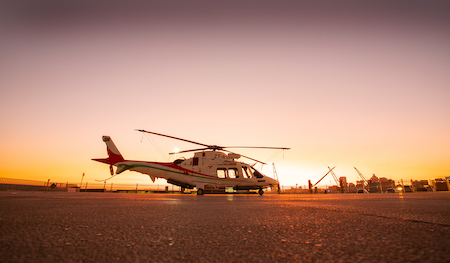
We land back at the base and shut down, keen to relax for a quick coffee break, but no sooner has the kettle boiled when the next call comes through. We receive the details of the vessel’s position, re-check gear and hop back into the helicopter. The container vessel that is exiting the harbor is leaving earlier than expected. The Transnet ship pilot boarded the vessel from the quayside, the tugs have positioned the vessel, and now he is steering her on her way. We take off and I’m hoisted down onto the end of the breakwater further along, well in front of the vessel, where there are no obstructions or people. I run back towards the vessel and get there just in time as the helicopter meets the container ship. The helicopter pilot flies alongside the vessel as it leaves through the harbor entrance, expertly positioning in a gap amongst the containers where the Transnet ship pilot is waiting to be hoisted up. This vessel operation was the most impressive of the full day of flying, because of the timing to meet the vessel at the last minute and the close hoisting confines on a containership traveling at speed. After taking the last photos of the ship pilot hoist, I ran back to the end of the breakwater, just in time to meet the helicopter for my hoist, and the flight back to base.
The helicopter crew can be tasked with search and rescue as required because of their specialist skills and access to a twin-engine helicopter, and they were deployed deployed during recent Durban floods. The twin-engine provides additional safety in case of engine failure, as the helicopter can still fly on one engine.
South Africa’s National Ports Authority’s medium-term aviation plans include expanding its helicopter fleet and HMPT services in the future. Based on the world-class operation I witnessed first-hand, you can see why the program has been so safe and successful.
VIEW TRANSNET AVIATION MARINE PILOT TRANSFERS VIDEO
READ TRANSNET AVIATION MARINE PILOT TRANSFERS FEATURE STORY
READ MORE ROTOR PRO: https://justhelicopters.com/Magazine
WATCH ROTOR PRO YOUTUBE CHANNEL: https://buff.ly/3Md0T3y
You can also find us on
Instagram - https://www.instagram.com/rotorpro1
Facebook - https://www.facebook.com/rotorpro1
Twitter - https://twitter.com/justhelicopters
LinkedIn - https://www.linkedin.com/company/rotorpro1